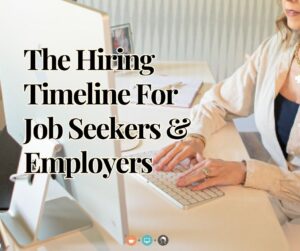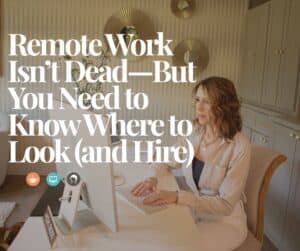The Hiring Timeline For Job Seekers And Employers

One of the biggest variables in the remote job market is time. Job seekers often ask, how long does it take to get hired for a remote job? Meanwhile, small business owners and employers wonder, how long should it take to hire someone for my team?
The Job Seeker’s Timeline
For job seekers, especially moms re-entering the workforce or looking for more flexible opportunities, the timeline can feel unpredictable. On average, it takes between three and six months to land a new role. Remote positions can take longer because competition is strong and the best jobs often receive a high number of applications.
That does not mean job seekers are powerless. The length of the process depends on several factors:
- The first is industry demand. Some roles like customer support, admin assistance, and social media management often fill quickly. More specialized roles, such as technical or executive-level positions, may take longer to secure.
- Application quality matters as well. Generic resumes often disappear into the pile, while tailored, personalized applications stand out.
- Consistency plays a role as well. Those who apply steadily to carefully selected opportunities see faster results than those who submit sporadically.
- Networking can also shorten the process considerably since connections often lead to opportunities.
Platforms like HireMyMom give job seekers an advantage by filtering out scams and irrelevant postings. By connecting directly with small businesses who want to hire experienced candidates for remote jobs, job seekers save time and find opportunities that are already aligned with their needs for flexibility and legitimacy. To make the process even easier, HireMyMom offers a variety of packages for job seekers that provide access to these carefully curated opportunities.
The Employer’s Timeline
Employers ask a slightly different question: How long should it take to hire someone for a remote role? Small businesses often do not have the luxury of waiting months to fill an urgent position. The longer a role sits open, the more work piles up and the more stressed business owners become.
Ideally, hiring for remote roles takes between one and three weeks. When an employer creates a clear job posting, targets the right audience, and communicates efficiently with applicants, the process moves quickly. At HireMyMom, many employers report hiring within days because they are reaching motivated, pre-screened candidates who are actively searching for flexible, family-friendly opportunities.
Additionally, the speed of hiring depends on the employer’s process. A vague job description leads to mismatched applications, slowing everything down. Posting on general job boards often means sifting through hundreds of unqualified candidates, which can drag out hiring for weeks. Posting on a specialized remote hiring platform allows employers to connect with reliable talent more efficiently. Employers who want to hire virtual assistants, part-time help, or project-based remote workers find the best results when they cut out unnecessary interview rounds and respond to candidates quickly. To support this, HireMyMom offers several packages for employers designed to make posting listings simple, affordable, and effective.
Why the Timelines Differ
The difference in timelines highlights an important reality: That job seekers and employers are operating on very different clocks. A job seeker may expect to search for months, while an employer wants their role filled within weeks. This gap can create frustration for both sides if expectations are not aligned.
For job seekers, it is important to recognize that employers often want to move quickly once they find the right fit. That means tailoring applications and responding promptly can make all the difference.
Staying Motivated as a Job Seeker
For moms looking for remote work, staying motivated during the search is half the battle. Setting aside regular time for applications helps keep the process consistent. Tracking progress, such as which jobs you have applied to and which employers responded, prevents discouragement and provides a sense of accomplishment. Even small wins like receiving a personalized reply can be encouraging. Building a strong resume through online courses or certifications also builds confidence and keeps resumes fresh. Applying on targeted sites like HireMyMom cuts down the wasted time spent on irrelevant or misleading postings.
Staying Efficient as an Employer
For employers, the key to faster and more successful hiring is clarity and focus. A detailed job posting with expectations for skills, hours, and pay reduces mismatches. Posting in the right place also matters. General boards might give volume, but specialized platforms like HireMyMom give quality. Speed of communication is another factor. Candidates who do not hear back quickly may accept offers elsewhere. Employers who respond promptly and keep their process simple find reliable remote employees faster and with less stress.
The Realistic Breakdown
So how long does it really take? For job seekers, expect one to six months to land a remote job depending on your field, application strategy, and level of flexibility. For employers, plan on two to three weeks if you create a clear job description, post in the right place, and communicate quickly with candidates.
The job search and hiring process are not always instant, but they do not have to be drawn-out or stressful either. For job seekers, persistence and consistency pay off. For employers, prepartion and clarity are the best tools for finding reliable talent.
If you are a mom asking yourself how long it takes to get hired for a remote job, the answer may be longer than you would like, but it is worth the effort. If you are a small business owner wondering how long it should take to hire someone, the answer is much shorter, provided you post your job where the right candidates are already looking and move the process along by communicating promptly with candidates.
HireMyMom exists to bridge that gap, helping job seekers and employers meet in the middle. By focusing on flexible, remote opportunities, we make it faster and easier for both sides to find the right fit.






